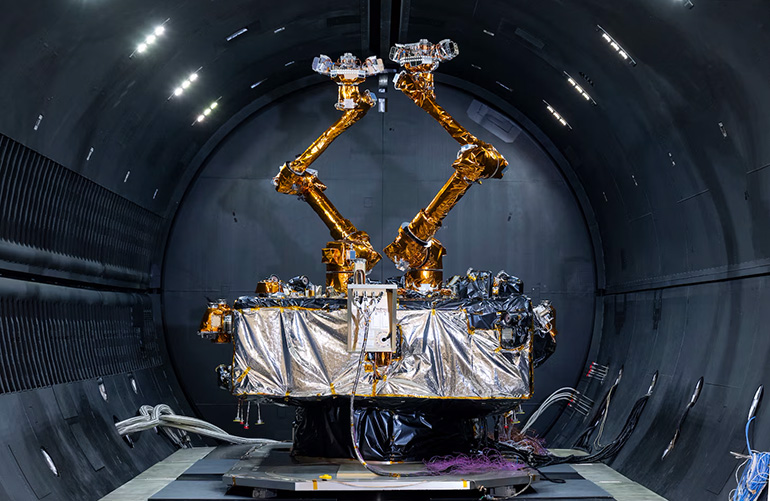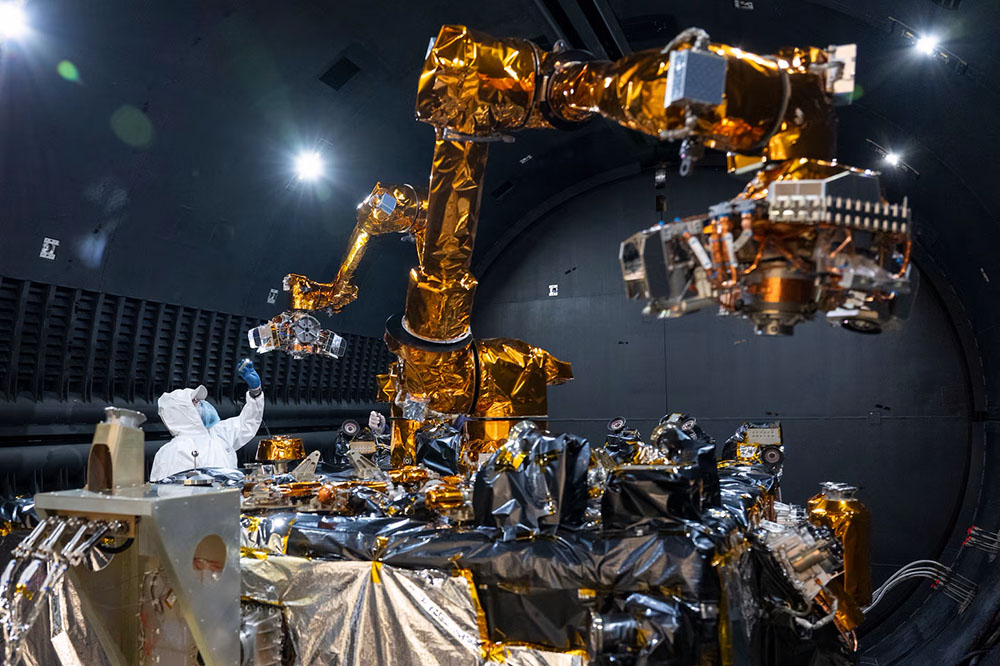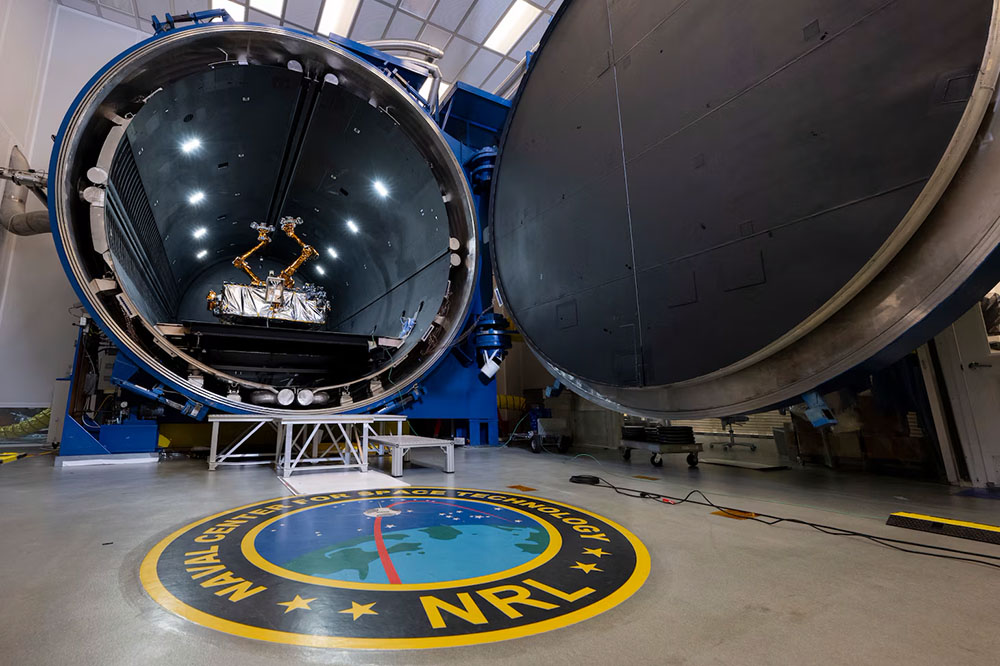|
Listen to this article |

The Robotic Servicing of Geosynchronous Satellites payload sits in the cryogenic thermal vacuum chamber at the Naval Center for Space Technology. | Credit: Sarah Peterson, U.S. Navy
Satellites in geosynchronous orbit about 22,000 miles above Earth are crucial for military, government, and commercial communications, as well as Earth-observing science. The U.S. Naval Research Laboratory, or NRL, and the Defense Advanced Projects Agency last month completed the development of a spaceflight-qualified robotics suite capable of servicing satellites in orbit.
Under DARPA funding, the laboratory‘s Naval Center for Space Technology (NCST) developed the Robotic Servicing of Geosynchronous Satellites (RSGS) Integrated Robotic Payload (IRP). The organization delivered this new space capability to commercial partner Northrop Grumman’s SpaceLogistics. The company will integrate the robotic payload with its spacecraft bus, the Mission Robotics Vehicle (MRV).
“The recent completion of thermal vacuum testing marks a major milestone toward achieving the program’s goal of demonstrating robotic servicing capabilities on orbit in the near future,” said Dr. Bruce Danly, NRL director of research.
“NRL’s contributions to the robotic payload are an essential part of realizing this vision, which promises to transform satellite operations in geostationary orbit, reduce costs for satellite operators, and enable capabilities well beyond what we have today,” he continued. “In fact, the anticipated capabilities are potentially revolutionary for both national security and civil applications.”
NRL has longstanding relationships with academia and industry as a collaborator and contractor. It participates in technology-transfer efforts such as commercial licensing, cooperative research and development, and educational partnerships.
The scientific and engineering command is dedicated to research for the U.S. Navy and Marine Corps, from the seafloor to space and the information domain. NRL is headquartered in Washington, D.C., with major field sites in Stennis Space Center, Miss.; Key West, Fla.; and Monterey, Calif. It employs approximately 3,000 civilian scientists, engineers, and support personnel.
NRL aims to unlock satellite servicing opportunities
Currently, spacecraft face significant challenges, in part because of the inability to perform in-orbit repairs or upgrades. To compensate for the lack of servicing options, satellites are often loaded with backup systems and excess fuel, leading to increased complexity, weight, and cost.
“The military regularly fixes aircraft, tanks, ships, and trucks that break,” said Glen Henshaw, Ph.D., senior scientist for robotics and autonomous systems at NRL. “We upgrade aircraft and ships with the latest radars, computers, and engines.”
“Satellites are the only expensive equipment we buy that can’t be repaired or upgraded once they are in the field, and this costs the taxpayer money,” he added. “RSGS is intended to change this situation. We intend to demonstrate that we can upgrade and repair these valuable assets using robots.”
As DARPA’s robotic payload developer for the RSGS program, NRL looked to design, build, integrate, and test new satellite-servicing capabilities. Should this project prove successful, satellites could receive in-orbit upgrades to extend their service lives, said Bernie Kelm, superintendent of the Spacecraft Engineering Division at NRL NCST.
“This collaboration unlocks new servicing opportunities for both commercial and government satellites, enabling usual-close inspections, orbital adjustments, hardware upgrades, and repairs,” he said. “We’ve created advanced spaceflight hardware and software that will significantly enhance satellite servicing operations, including all robotic controls.”

Steven Butcher, Technology Service Corp. space robotics and mechanisms engineer, inspects the RSGS payload after completing testing at the NRL’s Naval Center for Space Technology. | Credit: Sarah Peterson, U.S. Navy
About the Thermal Vacuum (TVAC) testing process
The test campaign put the robotic payload through its paces across the range of temperatures it will face while in orbit and under vacuum conditions similar to space. Engineers tested all aspects of the payload including avionics, cameras, and lights.
They also demonstrated all operations with each of the two robotic arms, including launch lock deployments, calibrations, and tool changing. The test also verified SpaceWire communications, robotic compliance, and visual servo control modes.
NRL worked for over two decades to mature the technology enabling the RSGS program. Its intent is to safely and reliably repair and upgrade satellites, some of which cost over a $1 billion.
In the near future, robotic satellite “mechanics” may extend the useful life of satellites with new electronics, propulsion, or sensor capabilities, said NRL. RSGS robots could demonstrate broad servicing as a precursor to building large structures in orbit such as an observatory or solar power stations, said the researchers.
Following its anticipated 2026 launch on the Northrop Grumman’s MRV spacecraft bus, the robotic payload will undergo initial checkout and calibration with full operational servicing missions to follow.
“NRL’s Team RSGS has spent nearly 10 years focused on the goal of completing this first-of-a-kind, robotic servicing payload,” said William Vincent, NRL RSGS program manager. “The completion of IRP TVAC represents a huge milestone and countless hours of work from an incredible group of dedicated personnel. Like sending a child off to college for the first time, shipping the IRP to Dulles is a bittersweet experience.”


